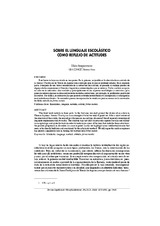Mostrar el registro sencillo del ítem
Sobre el lenguaje escolástico como reflejo de actitudes
| dc.contributor.author | Magnavacca, Silvia | |
| dc.date.accessioned | 2022-07-07T08:00:35Z | |
| dc.date.available | 2022-07-07T08:00:35Z | |
| dc.date.issued | 2012 | |
| dc.identifier.issn | 2530-7878 | |
| dc.identifier.issn | 1133-0902 | |
| dc.identifier.uri | http://hdl.handle.net/10396/23523 | |
| dc.description.abstract | Este breve trabajo se articula en tres partes. En la primera, se justificará la elección de un artículo de la Summa Theologiae de Tomás de Aquino como ejemplo para lo que se pretende señalar. En la segunda parte, y después de una breve recordación de la estructura del artículo, se procede al análisis puntual de algunas de las expresiones y fórmulas linguísticas estereotipadas que se reiteran. Dicho análisis se apoya no sólo en lo semántico sino también y principalmente en los aspectos morfológico y sintáctico, para poner en relieve algunos matices subyacentes en dichas estructuras, por ejemplo, la perifrástica pasiva del dicendum. Por último, se subrayarn las que parecen actitudes intelectuales ya incorporadas y consagradas en el método escolástico. Se sostendrá que esa incorporación ha tenido un peso no menor en la conversión de dicho método en forma mentis. | es_ES |
| dc.description.abstract | This brief work unfurls in three parts. In the first one, we shall ground the choice of an article in Thomas Aquinas’ Summa Theologiae as an example of what we wish to point out. After a short review of the structure of the article, the second part focuses on an analysis of some of the oft repeated stereotypical linguistic expressions and formulae. The analysis taps not only on semantic aspects but also and mainly on morphologic and syntactic traits in order to underscore some of the hues that underlie those structures: the passive periphrasis in dicendum is a case in point.Lastly, we highlight some intellectual stances that seem to be already built into and sanctioned by the scholastic method. We will argue that such acceptance has played a significant role in turning that method into forma mentis. | es_ES |
| dc.format.mimetype | application/pdf | es_ES |
| dc.language.iso | spa | es_ES |
| dc.publisher | UCOPress | es_ES |
| dc.rights | https://creativecommons.org/licenses/by-nc-nd/4.0/ | es_ES |
| dc.source | Revista Española de Filosofía Medieval 19, 39-43 (2012) | es_ES |
| dc.subject | Escolástica | es_ES |
| dc.subject | Lenguaje | es_ES |
| dc.subject | Método | es_ES |
| dc.subject | Actitud | es_ES |
| dc.subject | Forma mentis | es_ES |
| dc.subject | Scholastic | es_ES |
| dc.subject | Language | es_ES |
| dc.subject | Method | es_ES |
| dc.subject | Attitude | es_ES |
| dc.title | Sobre el lenguaje escolástico como reflejo de actitudes | es_ES |
| dc.type | info:eu-repo/semantics/article | es_ES |
| dc.relation.publisherversion | https://www.uco.es/ucopress/ojs/index.php/refime/index | es_ES |
| dc.rights.accessRights | info:eu-repo/semantics/openAccess | es_ES |

